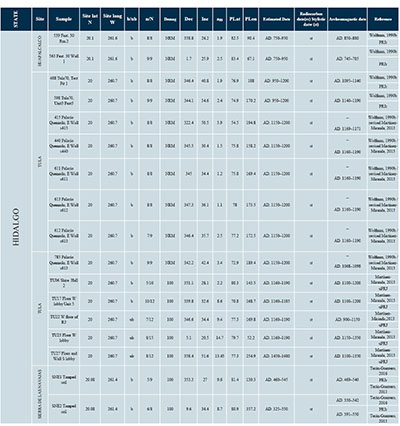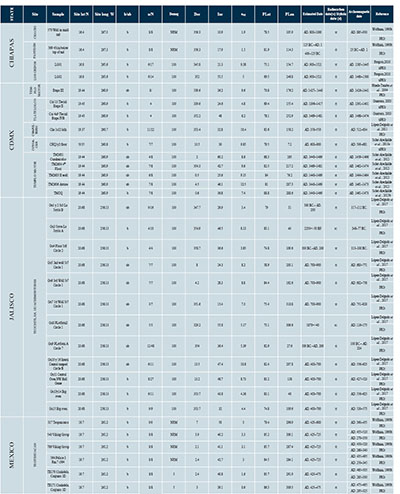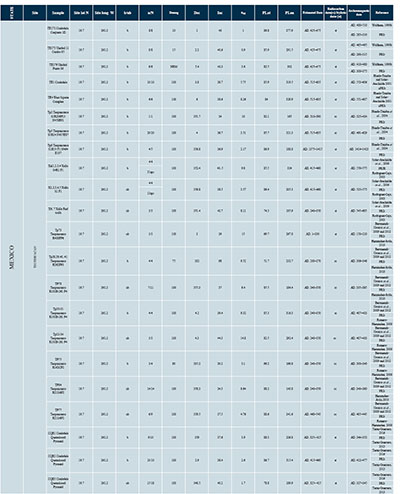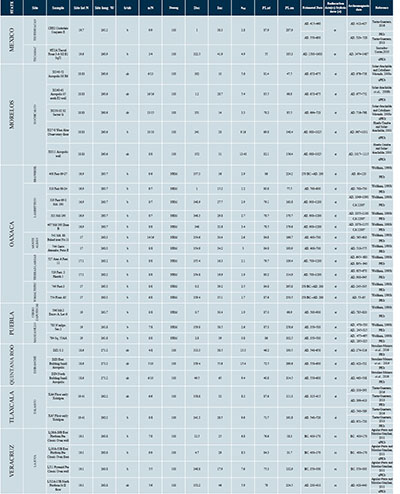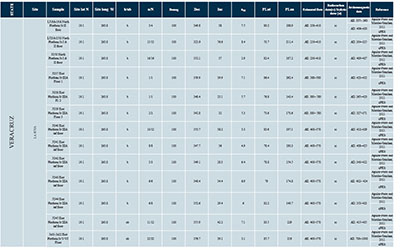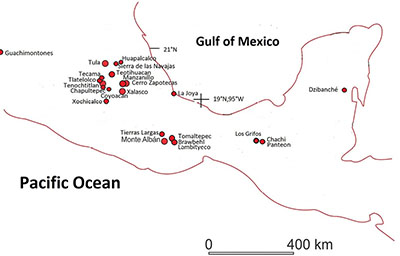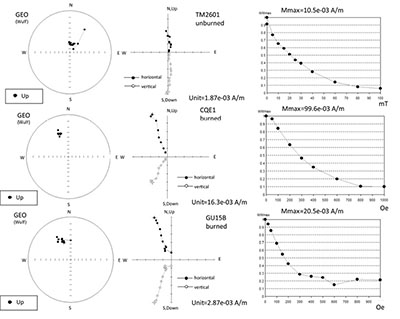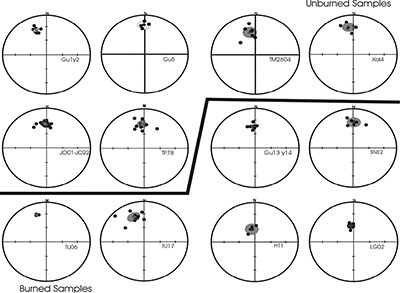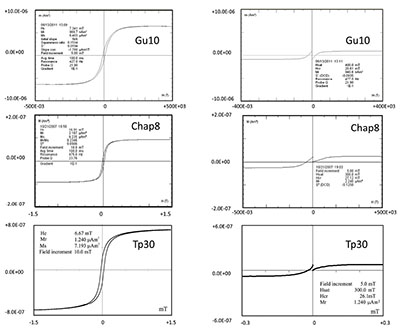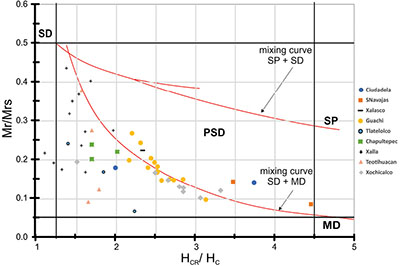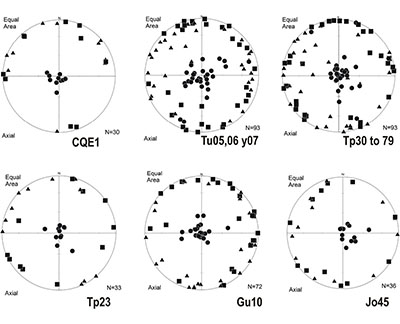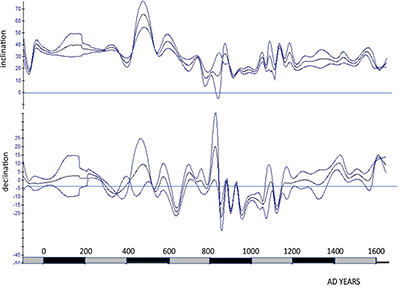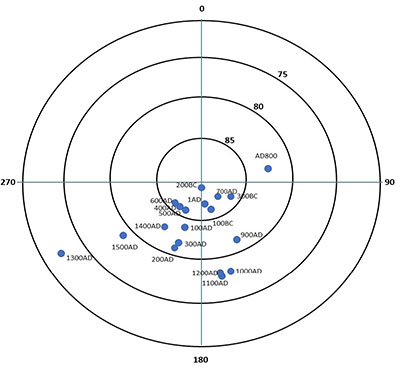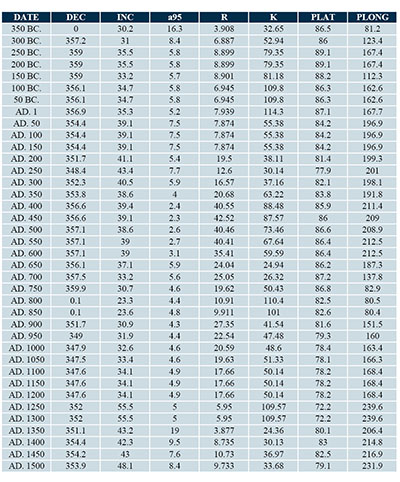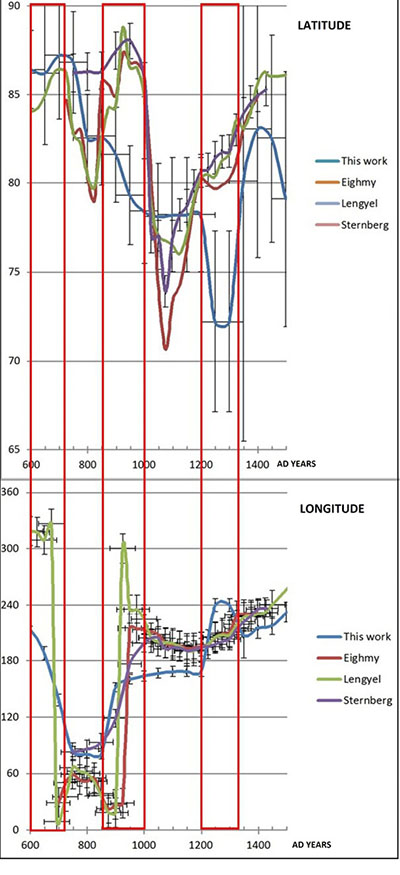|
Boletín de la Sociedad Geológica Mexicana Volumen 71, núm. 2, 2019, p. 497 ‒ 518 http://dx.doi.org/10.18268/ BSGM2019v71n2a16
|
 |
An updated catalog of pre-hispanic archaeomagnetic data for north and central Mesoamerica: Implications for the regional paleosecular variation reference curve
Ana Ma. Soler-Arechalde1,*, Cecilia Caballero-Miranda1, Ma. Luisa Osete-López2,
Verónica López-Delgado3, Avto Goguitchaichvili4, Alan Barrera-Huerta5, Jaime Urrutia-Fucugauchi1
1Instituto de Geofísica, Universidad Nacional Autónoma de México, Ciudad Universitaria, 04510, Coyoacan, CDMX, Mexico.
2Facultad de Ciencias Físicas, Departamento de Física de la Tierra, Astronomía y Astrofísica. Universidad Complutense. Plaza de Ciencias,1. Ciudad Universitaria. 28040, Madrid, Spain.
3Posgrado en Ciencias de la Tierra. Instituto de Geofísica. Universidad Nacional Autónoma de México. Campus Morelia. Antigua Carretera a Pátzcuaro 8701, Ex Hacienda de San José de la Huerta, 58190 Morelia, Michoacán, Mexico.
4Instituto de Geofísica. Universidad Nacional Autónoma de México. Campus Morelia. Antigua Carretera a Pátzcuaro 8701, Ex Hacienda de San José de la Huerta, 58190, Morelia, Michoacán, Mexico.
5Posgrado en Estudios Mesoamericanos. Universidad Nacional Autónoma de México. Ciudad Universitaria, 04510, Coyoacan, CDMX, Mexico.
*This email address is being protected from spambots. You need JavaScript enabled to view it.
Abstract
Despite the immense cultural heritage of Mesoamerica, there is still no reference archaeomagnetic curve available for Central Mexico and adjacent areas. The present research has two simultaneous objectives: to obtain finer characteristics of the geomagnetic field elements over archaeological past, and to build up a reliable regional archaeomagnetic dating tool for the time span of 350 BC. to 1500 AD. For these purposes, 72 previous were compiled and analyzed with 40 new data selected from unpublished reports and theses performed in the paleomagnetic laboratories of the Geophysics Institute of UNAM (CDMX and Morelia). Most of the samples carry thermo-remanent magnetization, 31 cases were unburned stuccos, and 3 mural paintings carrying detrital or pictorial remanent magnetization. A total of 112 archaeomagnetic directions constitute the core of the updated catalogue. Special effort should be paid for to the time intervals of 500 BC.—AD. 200 and AD. 1200–325 where there is a major lack of reliable archaeomagnetic results. The present paleosecular variation curve agrees reasonably well with the fluctuation observed in the SW United States area. The differences in the intervals between AD. 600–720, AD. 850 and 1000 and AD. 1200–1325 may be rather attributed to the lack of reliable data than to local non-dipole field. It is urgent to gather a greater number of high-quality data supported by radiometric ages to improve the reference curve in both regions.
Keywords: Archaeomagnetic dating, geomagnetic field, paleosecular variation, central Mexico.
Resumen
Aunque el patrimonio cultural de Mesoamérica es cuantioso, aún no se cuenta con una curva de variación secular del campo geomagnético mediante datos arqueomagnéticos para el centro de México y áreas adyacentes. La presente investigación persiguió dos objetivos: obtener características más precisas de los elementos del campo geomagnético en el pasado arqueológico para el lapso 350 aC. a 1500 dC., además de construir una herramienta de datación arqueomagnética confiable para el centro y Sur de México, región que corresponde con la porción central y norte de Mesoamérica. Para ello se compilaron y seleccionaron 72 resultados previamente publicados en revistas arbitradas junto con 40 datos provenientes de informes de proyectos o tesis. La mayoría de las muestras portan magnetización termo-remanente, únicamente 31 son estucos no quemados con magnetización remanente detrítica y 3 pinturas murales con magnetización remanente pictórica. Un total de 112 direcciones arqueomagnéticas constituyen el núcleo del catálogo actualizado. Es necesario un mayor número de datos respaldados por edades radiométricas y de mayor calidad para mejorar la curva de referencia en México, en particular para los lapsos entre 500 aC. y 200 dC. y entre 1200 dC y 1325 dC. La curva de variación paleosecular que se presenta muestra buena correlación con la fluctuación observada en el área SO de Estados Unidos. Las grandes diferencias entre ambas áreas para los lapsos 600–650 dC., 850–1000 dC. y 1200–1325 dC. pueden ser mayormente atribuidas a la falta de datos confiables más que al campo no dipolar local.
Palabras clave: Datación arqueomagnética, campo geomagnético, variación paleosecular, centro de México.
1. Introduction
The variation of the geomagnetic field in the archaeological past can be obtained from the well dated burned archaeological artifacts, bearing some spinels like titanomagnetites, as principal carriers. Archaeomagnetic data retrieved from thermoremanent magnetization are considered the most accurate and reliable compared to the data from lakes and sediments which may be smoothed and/or offset due to their magnetization acquisition process. These data are used to draw up regional PSV reference-curves or global prediction models building upon the knowledge of the geomagnetic field variations for the periods covering the last few millennia. Reference PSV curves can also be used for dating purposes by comparing the archaeomagnetic field information (direction and/or intensity) of archaeological material within a region with the known PSV curve of the Earth’s magnetic field for the corresponding region (Lanos and Dufresne, 2008; Pavón-Carrasco et al., 2011).Well-defined PSV curves in southwest USA are scarce (Sternberg and McGuire, 1990; Eighmy et al.,1990; Wolfman, 1990a) in contrast to Europe, where several well-defined PSV curves are available for different regions (Gómez-Paccard et al., 2006; Schnepp and Lanos, 2005; Gallet et al., 2002).
Mesoamerican culture in Mexico had great development, since the Olmec civilization, which left strong evidence of numerous big cities with trade networks that covered all of Mexico and Central America. Many investigations headed by the INAH (Instituto Nacional de Antropología e Historia) were carried out in the XX century elaborating regional sequences with ceramics and architectonic styles as chronological controls. The chronology was divided into three broad periods: The Formative or Preclassic from 2000 BC. to AD. 300, the Classic from AD. 300 to 950 and the Postclassic from AD. 950 to the contact with the Spaniard in AD. 1521. A period denominated Epiclassic between AD. 800–1200 corresponds to a brief flowering of secondary-states that grew with the collapse of great cities such as Teotihuacan and Monte Albán (López-Austin & López-Luján, 2014). By 1960 the radiocarbon method began to be employed, but due to the relatively high cost, the poorly constrained laboratory techniques or the lack of a rigorous sampling methodology, some aberrant dates were obtained and consequently unreliable sequences were developed. Wolfman (1990b) visualized the archaeomagnetic dating as a great tool to provide an unattainable precision for the chronometric results solving cultural-historical problems. He then published the first directional secular variation for Mesoamerica with samples of twelve sites in Mexico, two in Guatemala, one of Honduras and six in El Salvador. A total of 81 burned samples were measured in the Wolfman research and only one directly related to a radiocarbon date.
A compilation of previously available results for Mexico is here reported, 35 of Wolfman, 39 published in refereed journals, 12 of them unburned samples that includes 4 of pictorial origin. 38 samples complete the catalog of 112 archaeomagnetic directions to build upon a reliable PSV curve for central and southem Mexico. For each individual study, the main information has been detailed, including the field sampling procedures, laboratory treatment and archaeological and chronological information. Rock magnetic studies have been carried out to identify the main magnetic minerals and their thermal stability. In addition, these data may largely contribute to better constraining the variation of the Earth’s magnetic field in the North and Central Mesoamerica during the last two millennia.
2. Archaeomagnetic studies in Mexico
The directional component of the geomagnetic field from Preclassic to Postclassic (AD. 1–1200) recorded in burned materials of 12 sites of Mexico were reported by Wolfman (1990b). The site locations are mentioned in Table 1 and Figure 1. The measurements were carried out in the paleomagnetic laboratories of Oklahoma, Pittsburgh and California. In Oklahoma the samples were measured in a Princeton Applied Research (PAR) spinner magnetometer. In Pittsburgh, most of the samples were measured in a Superconducting Technology (SCT) cryogenic magnetometer, and some in a PAR spinner magnetometer. A SCT cryogenic magnetometer and a Schoendsted spinner magnetometer (SSM—1A) were used in almost all cases.
|
Table 1. Magnetic parameters of each sample. 1st State of sampling, 2nd archaeological site, 3rd name of sample and location, 4th and 5th geographic coordinates of site (Latitude, longitude). 6th if it is burned or unburned (b/ub), 7th the number of specimens employed to the calculus of media n and the total number of the specimens of the sample N. 8th Demag: NRM if the samples were not demagnetized or the AF field in mT until the sample were demagnetized. 9th ,10th and 11th Parameters of the media direction of the sample Dec, Inc and α95 of the Fisher statistic. 12th and 13th PLat (North Latitude) and PLong (East Longitude) of the VGP. 14th Estimated date 15th method of date estimation st - stylistic of ceramics or stratigraphy and rc - related to a radiocarbon date. 16th Archaeomagnetic date obtained by Rendate software (--see Tula text). 17th Reference: thesis or paper that reported the data and a key to identify if the data was Published in Referee Journals (PRJr) or in a thesis or internals reports (uPRr unPublised in Referree Journals).
|
Most directions of the Natural Remanent Magnetization (NRM) showed good clustering with α95 less than 4° and their temporalities consistent with other chronological contexts. Alternative-field demagnetization was done in Oklahoma and Pittsburg laboratories using over 10 samples, only 4 of Teotihuacan. With the 35 data samples from of Mexico in addition to the 29 samples from Guatemala, El Salvador and Honduras, Wolfman constructed the first secular variation curve for Mesoamerica. All the samples were dated by architectural style, ceramics or stratigraphy, which potentially decreases the accuracy of the curve.
2.1. Sites previously sampled by Wolfman
Chiapas state
Chachi y Panteón (16.4°N, 267.3°W). Site located at Maya lowlands of Chiapas, in the Central Depression occupied by Mixe-Zoque groups since 125 BC. to AD. 1000. Two samples were taken, 569 of earlier occupations and 570 of the latest.
Hidalgo State
Huapalcalco (20.1°N, 261.6°W). A site with its major development during the Epiclassic (AD. 700–900) due to the obsidian exploitation under Teotihuacan influence is considered as the precedent of Tula. Two samples were taken here from this period: samples 539 and 563.
Tula (20°N, 260.7°W). The capital city of the Toltecs, a Mesoamerican civilization that was developed between AD. 850 until AD. 1150. Wolfman sampled between 1969 and 1972, accepting that the chronology of the site ended around AD. 1000. New evidences and radiocarbon data allowed to expanding the chronology, related to samples 415, 440, 611, 613, 612 and 785, initially rejected by Wolfman. Samples accepted by Wolfman were 488 and 598.
Oaxaca State
Brawbehl (16.9°N, 263.7°W). This is the first settlement of Tlacolula Center, Valley of Oaxaca. A sample stratigraphically related to the time span 250 BC. to AD. 200 was taken, its number is 408.
Lambityeco (16.9°N,263.7°W). Site located in the Valley of Tlacolula and belonging to the Central valleys of Oaxaca. The age of this site seems to be contemporary with Monte Alban specialized in salt production. Its greatest splendor was during the Postclassic (AD. 800–1200), coinciding with the decline of Monte Alban. Four samples were obtained from Epiclassic to Postclassic: 318, 319, 321 and 407.
Monte Alban (17.0°N, 263.3°W). Zapotec site that dominated the central valleys of Oaxaca during the Classic (AD. 400–800). Two samples of this period were taken: 541 and 744.
Tierras Largas (17.1°N, 263.2°W). Formative-period site located in the Etla Valley of Oaxaca with the evidence of occupation until the Postclassic. Two samples of Postclassic (AD. 700–1200) were sampled: 527 and 529.
Tomaltepec (17.0°N, 263.3°W). Formative site of the central valleys of Oaxaca (200 BC.–AD. 250). Two samples were collected from this period: 749 and 754.
Puebla State
Cerro Zapotecas (19.0°N, 261.7°W). Epiclassic site (AD. 650–900) located west of Cholula, that grew with the latter’s decay. Sample: 596.
Manzanillo (19.0°N, 261.8°W). Located to the SW of Cholula, its remains correspond to a Classic site (AD. 350–500). Sample: 784.
State of Mexico
Teotihuacan (19.7°N, 261.2°W). This is one of the largest centers of Mesoamerica, it has an area of 20 km², large pyramids, ceremonial, administrative and residential areas where more than 100000 people lived. The population was multiethnic and five principal stages of occupation have been determined since AD. 1 to 650. The city was divided into the ceremonial area, and several neighborhoods as Teopancazco and Xalla among others. The ceremonial area and Teopancazco were sampled in 2000. During different excavation campaigns such as 2001, 2003 and 2005 more samples of these areas were taken. Samples of Wolfman are 317, 540, 786, 564, TE170, TE171, TE172, TE173, TE176.
2.2. Sampled sites since 1999 or revisited
Chiapas State
Los Grifos (16.8°N, 265.6°W). This is a rocky shelter with occupation from the Formative to the Postclassic. Two samples of the Postclassic yielded good results. Three samples from the Formative also showed good records but due to their temporality (8800 years BP) they were not reported in this work. Samples: LG01 and LG02.
Hidalgo State
Tula (20.0°N, 260.7°W). Revisited. New explorations and radiocarbon data suggest its chronology reaches at least until AD. 1200. 23 new samples from burned and unburned stuccos were taken in the area during 2010, only 5 with good results, 2 of them unburned with α95 less than 15. The low success rate of these samples might be caused by the low content of magnetic minerals, due to the abundance of limestones or because of the intense weathering, as a result of the industrial pollution, given that even samples with clear evidence of high temperatures do not record the magnetization. The samples with good results come from the 2010 excavation: TU06, TU17, TU22, TU23.
Sierra de las Navajas (20.8°N,261.4°W). One of the principal sites that provided obsidian to Teotihuacan since Tlamimilolpa era. It is located 50 km NW of Teotihuacan, in Hidalgo State and its remains are evidence that it was a large center to exploitation, work and distribution of obsidian. Ceramics of Tlamimilolpa, Xolalpan and Metepec (AD. 200–600) were recollected. Four oriented fragments belonging to burned soils were sampled in 2006. Samples: SNE1 and SNE2.
Jalisco State
Guachimontones (20.68°N, 256.13°W). Guachimontones of Teuchitlán is an archaeological site housed in a lake basin within the valleys of the Tequila volcano, West of Mexico. The site is characterized by circular structures of monumental size surrounded by platforms that were built with masonry, a mixture of rocks and fine clays. Two exhaustive sampling of detailed stratigraphic sequences were done in 2005 and 2009. Sixteen samples from the Pre-classic to the Epiclassic (300 BC.–AD. 900) were taken showing good agreement with the stratigraphy, ceramics and radiocarbon dates. Samples: Gu1y2*, Gu3, Gu4, Gu5, Gu6, Gu7, Gu8, Gu9, Gu10y16*, Gu11, Gu13y14* and Gu15 (*two samples but processed together).
Mexico City
Templo Mayor of Tenochtitlan (19.44°N, 260.9°W). Tenochtitlan is the city founded by the Mexicas in 1325, its different stages of evolution were marked by its different governors or tlatoanis. The site was sampled in 2000, but only one sample gave a good result. In 2012 a new excavation produced four samples with better results of two different stages. Samples: etapa III, TM2601, TM2604, TM2605 and TM2606.
Tlatelolco (19.45°N, 260.9°W). City located Northwest of the Templo Mayor of Tenochtitlán. This place was built in the year of 1337 by a group of Mexicas that left Tenochtitlán, and its constructive evolution is also marked by its governors. Two samples of burnt stucco are reported: Cui13 and Cui 4a9.
Chapultepec (19.37°N, 260.7°W). Hill located at West of Mexico City center. In 2004, remains of Teotihuacan-type habitation units were are located on the south slope of the hill. Ceramics of the Metepec and Coyotltatelco periods (AD. 550–900) were also found. Burned material of the surface of a kiln was sampled and identified like Cha1a22.
Coyoacan (19.37°N, 260.7°W). Postclassic (AD. 600–900) vestiges of a residential unit very damaged due to the construction of a “tlatel”, artificial fill to gain ground to the lake. Sample: CHQ1y2.
Morelos State
Xochicalco (18.83°N, 260.6°W). The city of Xochicalco is a fortified settlement of Epiclassic (AD. 600–1100). It is one of the cities that emerged due to the fall of Teotihuacan. Its location over a 300 m hill allowed it to control the trade networks between Morelos, Oaxaca and Mexico Basin. The first sampling of the site was in 1999, and new excavations and sampling were done in 2004, 2006 and 2007. Samples: XO40-52, XO60-61, XO30-32, XO7-8 AND XO11.
State of Mexico
Teotihuacan. (19.7°N, 261.2°W). Revisited. Samples: Tp2, Tp3, Tp8, Xal1,2, 3, 4, X1, 2, 3, 4, 5, X6, 7, Tp73, Tp38, 39, 40, 41, Tp78, Tp30-31, Tp32-34, Tp75, Tp84, Tp77, CQE1, CQE2, CQE3, CEE2.
Tecama (19.6°N, 260.9°W). It was founded in AD. 1200 by the Mexicas during their pilgrimage to Tenochtitlan. Two occupation stages were sampled: Azteca III (AD. 1300–1500) and Azteca IV (AD. 1500–1600). Sample: HT2A.
Quintana Roo State
Dzibanché (18.6°N, 271.2°W). Maya site occupied since 300 BC. to AD. 1500. During the Classic (AD. 450–700) was governed by Kaan dynasty. The samples come from murals taken from the main group of buildings, where two constructions of Classic stages were identified. The principal component of the red pigment is hematite. It was the first sampling of murals for archaeomagnetic studies in the Maya area. The sampling was done in 2014. Samples: DZ1, DZ3 and DZ4.
Tlaxcala State
Xalasco (19.41°N, 262.2°W). Site occupied by teotihuacanos since AD. 100 to 700. Five unburned stucco samples were taken in 2008, two gave good results: XA4 and XA7.
Veracruz State
La Joya (19.1°N, 263.8°W). La Joya is the capital of a political entity of the so-called Central Veracruz culture descendant of the Olmecs; a major site built of stamped earth, dating from 400 BC. to AD. 1000. The samples come from oven walls, burned floors and only two from unburned floors of two periods of excavation: 2005 and 2009. Samples: Lj26A-29B, Lj30A-33B, LJ11, LJ12A-15B, LJ16A-19A, LJ20A-25G, JO50, JO37, JO38, JO39, JO40, JO41, JO42, JO43, JO44, JO45 and Jo01-Jo22.
3. Methods
3.1. Sampling
The locations of the 40 new structures that are reported in this paper are shown in Figure 1 (geographic coordinates are shown in Table 1). Most of the structures are stuccos exposed to fire, oven or hearths (44 samples). Between 8 and 12 specimens were collected employing a wooden cylinder and oriented with a Brunton compass. In some cases, unburned stucco was also sampled because it was proved that they have a magnetic sedimentary fabric whose magnetic signal was enhanced due to the volcanic scoria and cinder that was added to the mortars (Hueda-Tanabe et al., 2004).
|
Figure 1. Location of the archaeological sites in Mexico sampled for archaeomagnetic research. |
3.2. Magnetic measurements
The NRM direction and intensity were measured with an AGICO JR6 magnetometer. Alternate Fields (AF) stepwise demagnetization was carried out over 8 to 12 steps until 100 mT in a Molspin demagnetizer to determine the main remanence components and stability of magnetization.
3.3. Rock magnetic properties
Hysteresis measurements and Isothermal Remanent Magnetization (IRM) cycles were performed using an AGFM Micromag magnetometer (Princeton Measurements Corp.) with maximum applied field of 1.2 T. Hysteresis parameters after paramagnetic correction were obtained: saturation magnetization (Ms), saturation remanence (Mrs) and coercitive force (Hc). IRM acquisition was measured for determination of coercitivity of remanence (Hcr). Anisotropy of Magnetic susceptibility (AMS) was measured in an AGICO´s Kappa bridge KlY2. This study was carried out to determine the magnetic fabric for unburned stuccos. In many sites of Mexico, cinder and volcanic scoria was added to the mortars and the anisotropy could reveal the preferred orientations when the stucco dries. We expected a sedimentary fabric, with the minor axes clustered and perpendicular to the plane of deposit. This fabric will allow inferring if the magnetization of unburned stuccos is of a sedimentary origin and if the measured direction is of a primary character.
4. Results
Many of the new data reported now are included in Bachelor and Master theses of students from Physics, Archaeology and Earth Sciences areas since 2003, whose paleomagnetic experiments and measurements were performed in the Paleomagnetic Laboratories of the Geophysics Institute of the National University of Mexico (CDMX and Morelia). Other data were reported in unpublished Reports requested by and delivered to the excavation projects headed by the INAH. These reports allow access to data from which there are no digital versions.
In many cases, specimens have a linear and univectorial component of magnetization and the characteristic remanent magnetization (ChRM) may be easily determined as may be observed in examples shown on Figure 2 for well heated and unburnt structures. Principal component analysis was used to get the primary magnetization direction of each sample. Fisher statistics was applied to obtain the mean direction of the samples (Fisher, 1953).
|
Figure 2. Stereonet, Vectorial Diagram and Demagnetization spectra of representative samples of unburned (TM2601) and burned (CQE1 and Gu15b) stuccos. |
The resulting data are listed in Table 1 and some stereonet examples are shown in Figure 3. We only consider acceptable the samples with α95 less than 10 and until 15 in the case of the unburned stuccos. Nine samples of this type are included in the present catalog belonging to some well identified archaeological contexts and with archaeomagnetic dates that correspond with the chronology of strata.
|
|
Some hysteresis and IRM cycles that exemplify the behavior of many of the samples are reported in Figure 4. The behavior observed corresponds to poor Ti titanomagnetites. Pseudosingle domains are preponderant in the modified Day diagram (Day et al., 1977) by Dunlop (2002) (Figure 5).
|
Figure 4. Hysteresis and IRM cycles of the samples Gu10, TU04, Tp30. |
Temperature-dependent magnetic susceptibility experiments carried out in a Bartington MS2 furnace indicate low-Titanium Titanomagnetites as the principal magnetic carrier. Hematites sometimes co-exist but their contribution in remanent magnetization appears to be minor.
Some examples of the AMS of unburnt and burned stuccos could be observed in the Figure 6. All of the magnetic fabrics are of sedimentary type supporting the hypothesis that the unburned stuccos can record the direction of the geomagnetic field at the time of deposition. Burned samples: CQE1, Tp30 to Tp59 of Teotihuacan and Tu05, 06y7 of Tula. Unburned samples: Tu23 of Tula, Gu10 of Teuchitlán and Jo45 of La Joya.
|
|
The archaeomagnetic dates of Wolfman (1990b) were obtained from the curve that he constructed following the distribution of the VGPs and their chronological order based on stratigraphic consideration, ceramics and architecture style. Wolfman proposed two curves: one from AD. 1 to 300 and the other from AD. 300 to 1200.
The curves have a gap between AD. 100 to 300 and between AD. 915 to 1060, because there is a lack of data for these periods. The dating was performed by the intersection of the curve with the direction considering its error (α95).
The secular variation curve from 50 BC. to AD. 1600 obtained in the year 2000 for the archaeomagnetic dating, included the Wolfman data (1990b) from Mexico, Salvador and Guatemala, as well as the lava flow of Xitle volcano (100 BC.–AD. 60) data of Urrutia-Fucugauchi (1996) and the stalagmite data DAS2 (AD. 750–1975) of Latham and co-workers (1986). We employed the crossing point technique (Le Goff et al.,2002; Noel and Batt,1990) to get the intersections with the curve and achieve the dating. To better constrain the dates, stratigraphic restrictions were considered. The whole dataset was reduced to Teotihuacan (19.7°N, 261.2°E) because the greatest number of samples comes from this emblematic site.
|
Figure 6. Magnetic Anisotropy Susceptibility of the burned samples: CQE1 of Teotihuacan TU05,06 & 7 of Tula, TP30 to TP59 of Teotihuacan and Gu10 of Teuchitlan. Anisotropy of Magnetic susceptibility of unburned samples: TU23 of Tula and JO45 of La Joya. (circles – minimum - k3, square - intermediated- k2, triangle -maximum – k1). |
In 2010 with the publication of the software Rendate (Lanos, 2008) a new curve was modeled with cubic splines and the previous directions were processed obtaining better age restrictions. Figure 7 shows the secular variation curves obtained. Most of the new excavation projects have been taking samples for radiocarbon dating improving the local chronologies (Beramendi et al., 2009) providing new data to complete and expand the secular variation curve of central and south Mexico.
|
Figure 7. Previous Secular variation curve reduced to Teotihuacan (19.7N,261.2E) with their errors ΔI and ΔD. The curve includes geological and archaeomagnetic data. |
Table 1 compiles all the information concerning the location of samples, and their features: burned or unburned (b/ub), number of specimen employed to calculate the statistical means n, the total number of the specimens in the sample N. The Demag column indicates NRM if the samples were not demagnetized or, the maximum peak demagnetizing field in mT. Dec, Inc and α95 are the parameters of the mean direction of the sample resulted from the Fisher statistic; plat and plong are the paleolatitude and paleolongitude of Virtual Geomagnetic Poles (VGP). Estimated date is the date of the sample assigned by ceramic style, stratigraphy (st) or radiocarbon date (rc) related. Archaeomagnetic date is the date obtained by Rendate software. A key to identify the data Published in Referee Journals (PRJr) or the data of thesis and internals reports (uPRr unPublished in Referee Journals). As can be observed the mean α95 of unburned samples is 8.5 and usually greater than 4°. For unburned samples we accept α95 values less than 15° because of the type magnetization and potential inclination error. In all cases of unburned stuccos, the magnetic fabric has been measured confirming the sedimentary fabric (Figure 6).
|
Figure 8. Stereonet of Virtual Geomagnetic Poles for Central and South of Mexico for 300 BC to AD 1500 every 100 years. |
5. The PSV curve for Central Mexico
The early proposed curve has been improved by including only data supported by dates obtained by other alternative methods, in our case only radiocarbon data are available. The stalagmite data (Latham et al., 1986) have been removed due to controversy in their records. The data of the Xitle (Urrutia-Fucugauchi ,1996) was also removed to include only archaeomagnetic samples.
The new curve presented includes the archaeomagnetic data of Wolfman (1990b) and those of the researches carried out in the Laboratory of Paleomagnetism of the UNAM (located in CDMX) and of Morelia Laboratory, the current National Archaeomagnetic Service since 1999, all of them compiled in Table 1.
Fisher’s statistic mean-directions and VGP poles were obtained every 50 years with a mobile window of 100 years. Table 2 shows the results and Figure 8 shows them in an equal area projection. It is important to point out that more data is still needed in the Preclassic time-span (500 BC.–AD. 200), and for the Postclassic especially after AD. 1100.
|
Table 2. Mean Fisher magnetic direction of geomagnetic field for Mexico every 50 years, obtained with a moving window of 100 years. Plat: North latitude of VGP, Plong: East longitude of VGP.
|
In Figure 9 we can observe the comparison results amongst the available curves for the SW of USA. The employed data are from papers of Eighmy et al., (1990), Lengyel and Eighmy (2002) and Sternberg and McGuire (1990). The data comes from the states of Colorado, Arizona, New Mexico, Arkansas, Missouri, Louisiana and Tennessee. Lengyel and Eighmy (2002) focused on a proposal to solve the problem of damping by the use of the moving window and to the small number of samples in certain periods. Some large differences are observed between AD. 600 to 650 and AD. 925 to 1100 which can be tentatively attributed more to the lack of reliable data in the SW of USA than to the local non-dipole field, but great differences can be observed between AD. 1200 to 1325 where the lack of data is in Mexico. It is evident that more high-quality data supported by radiometric ages are strongly needed to improve the reference curves of Mesoamerica and SW of USA. Special effort should be place on put to the time intervals of 500 BC. to AD. 200 and AD. 1200 to 1325, which represent the major lack of reliable archaeomagnetic results in Mexico.
|
|
Acknowledgment
This work was supported by CONACYT project n° 252149 and partly by UNAM-PAPIIT IN101717.
References
Aguilar-Parra, L.I., Morales-Sánchez, R., 2011, Estudio arqueomagnético: Una aplicación a la cronología de la arquitectura de tierra en el sitio “La Joya”, Veracruz: Mexico, Escuela Nacional de Antropología e Historia, Bsc thesis of Archaeology, 195 p.
Beramendi-Orosco, L.E., González-Hernández, G., Soler-Arechalde, A.M., 2012, Cronología para Teopancazco: Integración de datos arqueomagnéticos a un modelo bayesiano de radiocarbono, in Manzanilla L R. (ed.), Una aportación a la cronología de Mesoamérica. Estudios Arqueométricos del centro de barrio de Teopancazco en Teotihuacan: Mexico, IIA-UNAM, 111–134.
Beramendi-Orosco, L.E., González-Hernández, G., Urrutia-Fucugauchi, J., Manzanilla, L. R., Soler-Arechalde, A.M., Goguitchaishvili A., Jarboe, N., 2009, High-resolution Chronology for the Mesoamerican Urban Center of Teotihuacan Derived from Bayesian Statistics of Radiocarbon and Archaeological Data: Quaternary Research, 71(2), 99–107.
Day, R., Fuller, M., Schmidt, V.A., 1977, Hysteresis properties of titanomagnetites: grain size and compositional dependence: Physics of the Earth and Planetary Interiors, 13, 260–267.
Dunlop, D.J., 2002, Theory and application of the Day plot (Mrs/Ms versus Hcr/Hc) 1. Theoretical curves and tests using titanomagnetite data: Journal of Geophysical Research. B: Solid Earth, 107(3), 5-1-5-15.
Eighmy, J.L., Hathaway, J.H, Kane, A.E, 1990, Archaeomagnetic Secular Variation in the American Southwest, AD. 700-900: Final Results from the Dolores Archaeological Program, in Eighmy J.L., Sternberg, R.S. (eds.), Archaeomagnetic dating: Tucson, The University of Arizona Press, 226–236.
Fisher, R.A., 1953, Dispersion on a sphere: Proceedings of the Royal Society of London, A217, 295–305.
Fregoso, D., 2010, Estudio Arqueomagnético del Abrigo Rocoso “Los Grifos”, Chiapas. Sitio de Ocupación Temprana en América: Mexico, Universidad Nacional Autónoma de Mexico, Bsc Thesis of Physics, 124 p.
Gallet, Y., Genevey, A., Le Goff, M., 2002, Three millennia of directional variation of the Earth’s magnetic field in western Europe as revealed by archeological artefacts: Physics of the Earth and Planetary Interiors, 131(1), 81–89.
Gómez-Paccard, M., Chauvin, A., Lanos, P., McIntosh, G., Osete, M. L., Catanzariti, G., Ruiz-Martínez, V. C., 2006, First archaeomagnetic secular variation curve for the Iberian Peninsula: Comparison with other data from western Europe and with global geomagnetic field model: Geochemistry, Geophysics and Geosystems, 7(12),1–20.
Guerrero, X., 2003, Análisis Arqueomagnético de Estucos del Valle de Mexico: Mexico, Universidad Nacional Autónoma de Mexico, Bsc Thesis of Physics, 40 p.
Hernández-Ávila, E. R., 2010, Control Cronométrico basado en arqueomagnetismo de Teopancazco, Estado de México: Mexico, Universidad Nacional Autónoma de Mexico, Bsc Thesis of Physics, 104 p.
Hueda-Tanabe, Y., Soler-Arechalde, A.M., 2001. Fechamiento arqueomagnético de los estucos en los sitios de Teopancazco, Teotihuacan y Templo Mayor, Tenochtitlán: Mexico, Informe presentado al Consejo de Arqueología del INAH en Agosto de 2001.
Hueda-Tanabe, Y., Soler-Arechalde, A.M., Urrutia-Fucugauchi, J., Barba, L., Manzanilla, L., Rebolledo, M., Gogitchaishvili, A., 2004. Archaeomagnetic studies in central Mexico –dating of Mesoamerican lime-plasters: Physics of Earth and Planetary Interiors, 147, 269–283.
Lanos, P., Dufresne, P., 2008. Bayesian Archaeomagnetic and Radiocarbon dating: the RenDate software, in Radiocarbon and Archaeology, 5th International Symposium. Zurich, Switzerland.
Latham, A.G., Schawrz, H.P., Ford, D.C. 1986. The paleomagnetism and U-Th dating of Mexican stalagmite. Earth and Planetary Science Letters, 79, 195–207.
LeGoff, M., Gallet, Y., Genevey, A., Warmé, N., 2002. On archeomagnetic secular variation curves and archeomagnetic secular variation curves and archaeomagnetic dating. Physics of Earth and Planetary Interiors, 134, 203–211. doi.org/10.1016/S0031-9201(02)00161-9
Lengyel, S.N., Eighmy, J.L., 2002, A Revision to the U.S. Southwest Archaeomagnetic Master Curve: Journal of Archaeological Science, 29, 1423–1433. doi:10.1006/jasc.2001.0807
López-Austin, A., López-Luján, L., 2014, Las Grandes Divisiones, in El pasado indígena: México, FCE, Colmex and FHA, 70–74.
López-Delgado, V., Soler-Arechalde, A.M., Esparza-López, J. R., Goguitchaichvili, A., Caballero-Miranda, C.I., Morales, J., 2017, Guachimontones de Teuchitlán: un estudio arqueomagnético para mejorar la cronología del Occidente de Mexico: Arqueologia Iberoamericana 33, 27–34
López-Delgado, V., Soler-Arechalde, A.M., Espinosa-Rodríguez, G., Goguitchaichvili, A., 2011, Rock-magnetic and archeomagnetic survey from some classical settlements at Chapultepec archeological site (western Mesoamerica): Studia Geophysica et Geodaetica, 55(2), 329–342
Martínez-Miranda, V., 2013, Tula el tiempo perdido- Fechamientos arqueomagnéticos: Mexico, Escuela Nacional de Antropologia e Historia: Bsc thesis in Archaeology,191 p.
Noel, M., Batt, C., 1990, A method for correcting geographically separated remanence directions for the purpose of archaeomagnetic dating: Geophysical Journal International, 102, 753–756.
Pavón-Carrasco, F.J., Rodríguez-González, J., Osete, M.L., Torta J.M., 2011, A Matlab tool for archaeomagnetic dating: Journal of Archaeological Science, 38(2), 408–419.
Rodríguez-Ceja, M., 2003, Análisis y Fechamiento arqueomagnético de estucos de Zonas habitacionales de Teotihuacan (Xalla) y Templo Mayor: Mexico, Universidad Nacional Autónoma de Mexico, Bsc Thesis of Physics, 65 p.
Romero-Hernández, E., 2008, Fechamientos Arqueomagnéticos de pisos con control estratigráfico de la excavación Teopancazco 2005, Teotihuacan: Universidad Nacional Autónoma de Mexico, Mexico, Bsc Thesis of Physics, 51 p.
Saavedra-Cortes, S. P., 2010, Estudio arqueomagnético en el área de Tecamac, Estado de México: Mexico, Universidad Nacional Autónoma de Mexico, Bsc Thesis of Physics, 85 p.
Sánchez-López, F., 2005, Nuevos fechamientos arqueomagnéticos de Xalla y Teopancazco, zonas habitacionales de Teotihuacan: Universidad Nacional Autónoma de Mexico, Mexico, Bsc Thesis of Physics, 80 p.
Schnepp, E., Lanos, P., 2005, Archaeomagnetic secular variation in Germany during the past 2500 years: Geophysical Journal International, 163(2), 479–490.
Sternberg, R.S., McGuire, R.H., 1990, Archaeomagnetic Secular Variation in American Southwest, A.D. 700-1450, in Eighmy J.L., Sternberg, R.S. (eds.), Archaeomagnetic dating: Tucson, The University of Arizona Press, 199–225.
Straulino-Mainou, L., Sedov, S., Soler-Arechalde, A.M., Pi-Puig, T., Villa, G., Balanzario-Granados, S., Doménech-Carbó, M.T., Osete-Cortina, L., Leonard, D., 2016, Maya Lime Mortars-Relationship between Archaeomagnetic Dating, Manufacturing Technique, and Architectural Function-The Dzibanché Case: Geosciences, 6(49), 1–27.
Soler-Arechalde, A.M., Barrera, A., Morales, R., 2012. Reporte de Datación arqueomagnética Templo Mayor, CDMX. Technical report delivered to Excavation Project Leader of INAH, 21p.
Soler-Arechalde, A.M., Barrera, A., 2013b. Reporte de Datación Arqueomagnética Ofrenda 161, Plaza Manuel Gamio, Templo Mayor, D.F.: Technical Report delivered to Excavation Project Leader of INAH, 9p.
Soler-Arechalde, A.M., Barrera, A., Martínez Longoria, A., 2013a, Reporte de Datación Arqueomagnética Templo de la Inmaculada Concepción, Coyoacán, DF: Technical report delivered to Excavation Project Leader of INAH, 14 p.
Soler-Arechalde, A.M., Caballero Miranda, C., 2008a, Reporte de Fechamiento Arqueomagnético. Xochicalco 2006: Technical report delivered to Excavation Project Leader of INAH, 6 p.
Soler-Arechalde, A.M., Orea, A., Caballero Miranda, C., 2008b, Reporte de Fechamiento Arqueomagnético. Xochicalco 2007: Technical report delivered to Excavation Project Leader of INAH, 9 p.
Soler-Arechalde, A. M., Sánchez, F., Rodríguez, M., Caballero-Miranda, C., Goguitchaishvili, A., Urrutia-Fucugauchi, J., Manzanilla, L., Tarling, D. H., 2006, Archaeomagnetic investigation of oriented pre-Columbian lime-plasters from Teotihuacan, Mesoamerica: Earth, Planets and Space, 58(10), 1433–1439.
Terán-Guerrero, A.G., Soler Arechalde A.M., Gogichaishvili A., Caballero-Miranda, C., Morales, J., Urrutia-Fucugauchi, J., 2016, Dataciones arqueomagnéticas en la Ciudadela de Teotihuacán, Sierra de las Navajas y Xalasco: Arqueología Iberoamericana, 29, 15–20.
Terán-Guerrero, A. G., 2013, Estudios arqueomagnéticos en Ciudadela, Sierra de las Navajas y Xalasco, Cultura Teotihuacana: Mexico, Universidad Nacional Autónoma de Mexico, Master thesis in Earth Sciences,155 p.
Urrutia-Fucugauchi, J., 1996, Paleomagnetic Study of the Xitle-Pedregal de San Angel lava flow, southern basin of Mexico: Physics of the Earth and Planetary Interiors 97, 177–196.
Wolfman, D., 1990a, Archaeomagnetic Dating in Arkansas and the Border Areas of Adjacent States-II, in Eighmy J.L., Sternberg R.S. (eds.), Archaeomagnetic dating: Tucson, The University of Arizona Press, 237–260.
Wolfman, D., 1990b, Mesoamerican Chronology and Archaeomagnetic A.D. 1-1200, in Eighmy J.L., Sternberg R.S. (eds.), Archaeomagnetic dating: Tucson, The University of Arizona Press, 261–308.
Manuscript received: January 8, 2018.
Corrected manuscript received: July 10, 2018.
Manuscript accepted: August 2, 2018.

